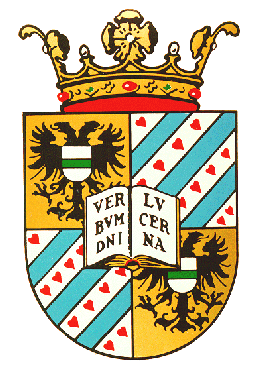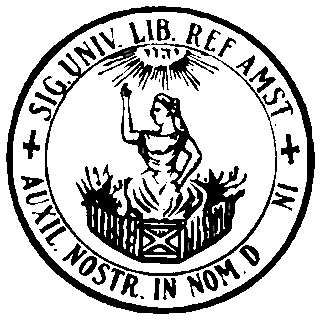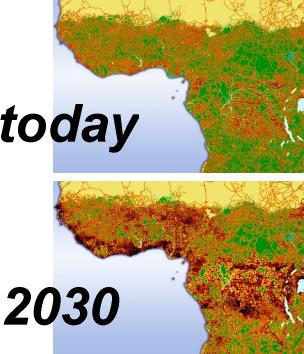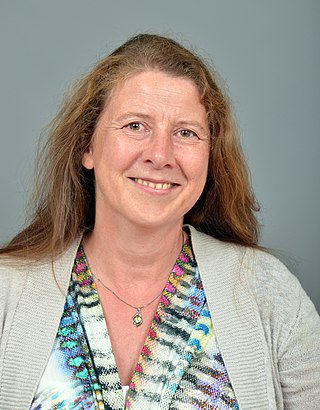
Landscape ecology is the science of studying and improving relationships between ecological processes in the environment and particular ecosystems. This is done within a variety of landscape scales, development spatial patterns, and organizational levels of research and policy. Concisely, landscape ecology can be described as the science of "landscape diversity" as the synergetic result of biodiversity and geodiversity.

The University of Groningen is a public research university of more than 30,000 students in the city of Groningen in the Netherlands. Founded in 1614, the university is the second oldest in the country and one of the most traditional and prestigious universities in the Netherlands.

Urban ecology is the scientific study of the relation of living organisms with each other and their surroundings in an urban environment. An urban environment refers to environments dominated by high-density residential and commercial buildings, paved surfaces, and other urban-related factors that create a unique landscape. The goal of urban ecology is to achieve a balance between human culture and the natural environment.

The Vrije Universiteit Amsterdam is a public research university in Amsterdam, Netherlands, being founded in 1880. The VU Amsterdam is one of two large, publicly funded research universities in the city, the other being the University of Amsterdam (UvA). The literal translation of the Dutch name Vrije Universiteit is "Free University". "Free" refers to independence of the university from both the State and the Dutch Reformed Church. Both within and outside the university, the institution is commonly referred to as "the VU". Although founded as a private institution, the VU has received government funding on a parity basis with public universities since 1970. The university is located on a compact urban campus in the southern Buitenveldert neighbourhood of Amsterdam and adjacent to the modern Zuidas business district.
Freshwater ecosystems are a subset of Earth's aquatic ecosystems. They include lakes, ponds, rivers, streams, springs, bogs, and wetlands. They can be contrasted with marine ecosystems, which have a larger salt content. Freshwater habitats can be classified by different factors, including temperature, light penetration, nutrients, and vegetation. There are three basic types of freshwater ecosystems: Lentic, lotic and wetlands. Freshwater ecosystems contain 41% of the world's known fish species.

The benthic zone is the ecological region at the lowest level of a body of water such as an ocean, lake, or stream, including the sediment surface and some sub-surface layers. The name comes from ancient Greek, βένθος (bénthos), meaning "the depths." Organisms living in this zone are called benthos and include microorganisms as well as larger invertebrates, such as crustaceans and polychaetes. Organisms here generally live in close relationship with the substrate and many are permanently attached to the bottom. The benthic boundary layer, which includes the bottom layer of water and the uppermost layer of sediment directly influenced by the overlying water, is an integral part of the benthic zone, as it greatly influences the biological activity that takes place there. Examples of contact soil layers include sand bottoms, rocky outcrops, coral, and bay mud.
The diversity of species and genes in ecological communities affects the functioning of these communities. These ecological effects of biodiversity in turn are affected by both climate change through enhanced greenhouse gases, aerosols and loss of land cover, and biological diversity, causing a rapid loss of biodiversity and extinctions of species and local populations. The current rate of extinction is sometimes considered a mass extinction, with current species extinction rates on the order of 100 to 1000 times as high as in the past.

Habitat fragmentation describes the emergence of discontinuities (fragmentation) in an organism's preferred environment (habitat), causing population fragmentation and ecosystem decay. Causes of habitat fragmentation include geological processes that slowly alter the layout of the physical environment, and human activity such as land conversion, which can alter the environment much faster and causes the extinction of many species. More specifically, habitat fragmentation is a process by which large and contiguous habitats get divided into smaller, isolated patches of habitats.

Functional ecology is a branch of ecology that focuses on the roles, or functions, that species play in the community or ecosystem in which they occur. In this approach, physiological, anatomical, and life history characteristics of the species are emphasized. The term "function" is used to emphasize certain physiological processes rather than discrete properties, describe an organism's role in a trophic system, or illustrate the effects of natural selective processes on an organism. This sub-discipline of ecology represents the crossroads between ecological patterns and the processes and mechanisms that underlie them. It focuses on traits represented in large number of species and can be measured in two ways – the first being screening, which involves measuring a trait across a number of species, and the second being empiricism, which provides quantitative relationships for the traits measured in screening. Functional ecology often emphasizes an integrative approach, using organism traits and activities to understand community dynamics and ecosystem processes, particularly in response to the rapid global changes occurring in earth's environment.
Soil ecology is the study of the interactions among soil organisms, and between biotic and abiotic aspects of the soil environment. It is particularly concerned with the cycling of nutrients, formation and stabilization of the pore structure, the spread and vitality of pathogens, and the biodiversity of this rich biological community.
The following outline is provided as an overview of and topical guide to ecology:

Sallie Watson "Penny" Chisholm is an American biological oceanographer at the Massachusetts Institute of Technology. She is an expert in the ecology and evolution of ocean microbes. Her research focuses particularly on the most abundant marine phytoplankton, Prochlorococcus, that she discovered in the 1980s with Rob Olson and other collaborators. She has a TED talk about their discovery and importance called "The tiny creature that secretly powers the planet".

Amsterdam Science Park is a science park in the Oost city district of Amsterdam, Netherlands with foci on physics, mathematics, information technology and the life sciences. The 70 hectare park provides accommodations for science, business and housing. Resident groups include institutes of the natural science faculties of the University of Amsterdam, several research institutes, and related companies. Three of the colocations of the Amsterdam Internet Exchange are at the institutes SURFsara, NIKHEF, and Equinix-AM3 at the science park.
Pier Vellinga is an environmental scientist and one of the Netherlands' experts on the impacts of climate change.
Ecological forecasting uses knowledge of physics, ecology and physiology to predict how ecological populations, communities, or ecosystems will change in the future in response to environmental factors such as climate change. The goal of the approach is to provide natural resource managers with information to anticipate and respond to short and long-term climate conditions.
Landscape limnology is the spatially explicit study of lakes, streams, and wetlands as they interact with freshwater, terrestrial, and human landscapes to determine the effects of pattern on ecosystem processes across temporal and spatial scales. Limnology is the study of inland water bodies inclusive of rivers, lakes, and wetlands; landscape limnology seeks to integrate all of these ecosystem types.

Hotspot Ecosystem Research and Man's Impact On European Seas (HERMIONE) is an international multidisciplinary project, started in April 2009, that studies deep-sea ecosystems. HERMIONE scientists study the distribution of hotspot ecosystems, how they function and how they interconnect, partially in the context of how these ecosystems are being affected by climate change and impacted by humans through overfishing, resource extraction, seabed installations and pollution. Major aims of the project are to understand how humans are affecting the deep-sea environment and to provide policy makers with accurate scientific information, enabling effective management strategies to protect deep sea ecosystems. The HERMIONE project is funded by the European Commission's Seventh Framework Programme, and is the successor to the HERMES project, which concluded in March 2009.
A drought refuge is a site that provides permanent fresh water or moist conditions for plants and animals, acting as a refuge habitat when surrounding areas are affected by drought and allowing ecosystems and core species populations to survive until the drought breaks. Drought refuges are important for conserving ecosystems in places where the effects of climatic variability are exacerbated by human activities.
The Environmental Change Institute at the University of Oxford in England was founded in 1991 "to organize and promote interdisciplinary research on the nature, causes and impact of environmental change and to contribute to the development of management strategies for coping with future environmental change".

Corina Brussaard is a leading scientist for Antarctic viral ecology working for the Royal Institute of Sea Research (NIOZ) and is a Special Professor of Viral Ecology at the Institute for Biodiversity and Ecosystem Dynamics of the University of Amsterdam (UvA).











